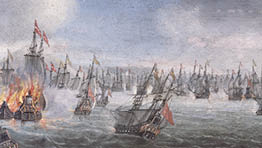
Online finds catalogue
The salvaged objects from the marine archeological investigations in the Fehmarn Belt have given a picture of the forces at play in a naval battle; when cannon gunfire smashes the ship's side and the wood shatters, when the fire from a burner reaches the gunpowder chamber and the ship explodes. The finds testify to the violence of the Torstenson feud and the human destinies.
But objects and ship models can also illuminate larger perspectives such as shipbuilding in the 17th century, artful decorations of cannons, and life aboard naval ships.
The online finds catalogue shows a selection of finds and objects exhibited at the 'In Smoke and Flames' exhibition, and is accompanied by small in-depth narratives that there were not room for at the exhibition.
Items
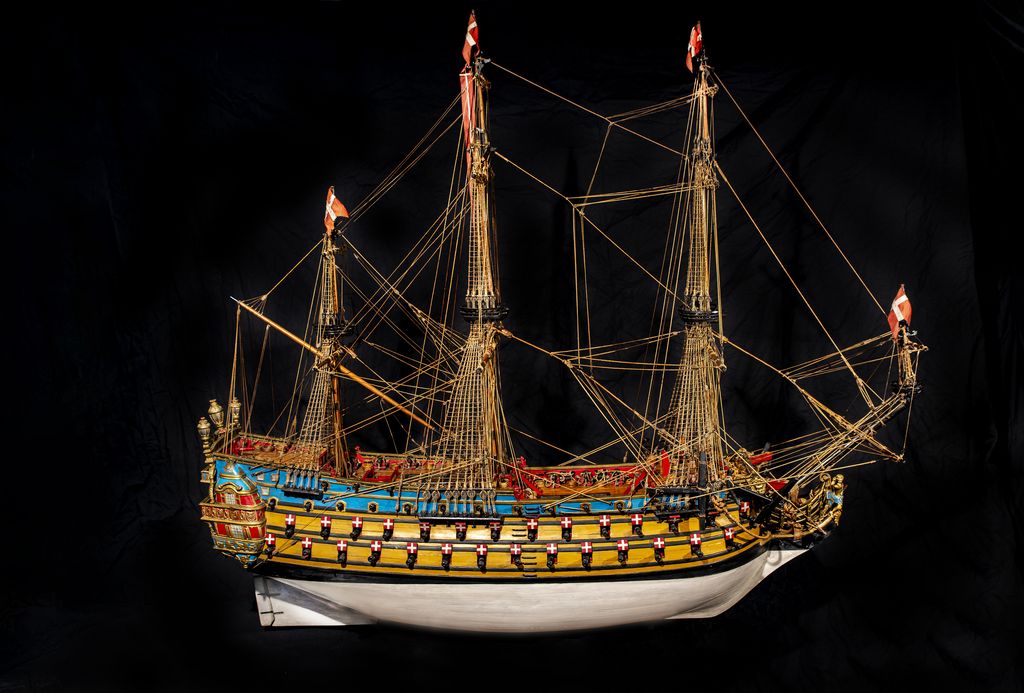
In 1963, a model of the warship, Christianus Quintus, was hung up in Skt. Jørgensbjerg Church in Roskilde.
The model ship was built by carpenter Poul Erik Thomsen, who donated the model to the church.
In 2018, the church’s parish council decided to take down the ship and donate it to a suitable recipient: the Viking Ship Museum.
During Christian V’s reign (1670 -1699), three great warships were built, all of which were named Christianus Quintus. The first in 1666, the second in 1683 and the third in 1699.
However, the King didn’t live to see the completion of the third ship. Christian V died four months before the ship was launched and the ship’s name was therefore changed to Fredericus Quartus, in reference to the new king.
That wasn’t the only alteration that the ship underwent on its journey from the drawing board to completed ship. The drawing from 1697, which was used as the basis for Thomsen’s model, depicts the ship as being 160 feet (ca. 50.2 m) long and with an intended 90 guns. By the time of its launch in 1699, the ship had become considerably bigger: ca. 58 m long and carrying 110 guns and a crew of 950 men. Fredericus Quartus was the world’s largest warship.
The model has been built in extreme detail at a scale of 1:50. The level of carving and painting work is highly impressive. On the stern, you can see Christian V’s motto, Pietate et Iustitia (with piety and justice). Although the model represents a warship that was larger than the ships that took part in the Torstenson Feud, it nonetheless gives a fine impression of 17th century warships and the art of ship-building.
» See more pictures of the the warship here
» See the film from when the warship arrived af the Viking Ship Museum here
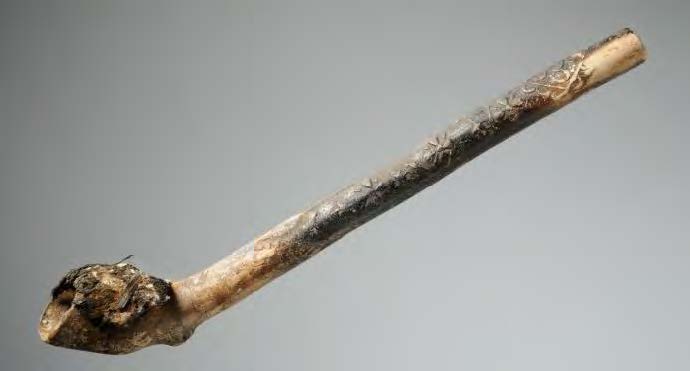
Christian IV was not overly enthused about smoking when it became fashionable in Europe at the beginning of the 17th century.
And especially not on board his fleet: almost everything on a ship is flammable and smoking was therefore strictly forbidden. If a seaman or officer chose to sneak out to smoke a pipe despite this order, the punishment was keel-hauling: a maritime punishment, where the sentenced had their hands and feet bound and were dragged under the ship from gunwale to gunwale, sometimes to the death.
Despite the severe punishment and the risk of fire on board, the maritime archaeologists from Landesmuseum Schleswig-Holstein found six pipe bowls, sixteen stem fragments and one almost intact clay pipe in the wreck of the Danish warship Lindormen. It would seem that the ship’s crew neglected to follow the King’s orders.
Three of the pipe bowls were engraved with the latters EB, which possibly refer to the English pipemaker, Edward Bird. In the beginning of the 17th century, he settled in Amsterdam, where he became the owner of one of the city’s largest pipe businesses. Bird’s clay pipes weren’t known for their quality or seen as a fashionable accessory, rather, they were a pipe for the working folk – and perhaps EB pipes were also common amongst the Danish seamen.
The clay pipe on display was found near a skeleton of one of the seamen. The stem is decorated with a 9 cm long flower motif (fleur-de-lis), which was popular at the time.
The clay pipe is kindly on loan from Museum für Archäologie Schloss Gottorp, Landemuseum Schleswig-Holstein.
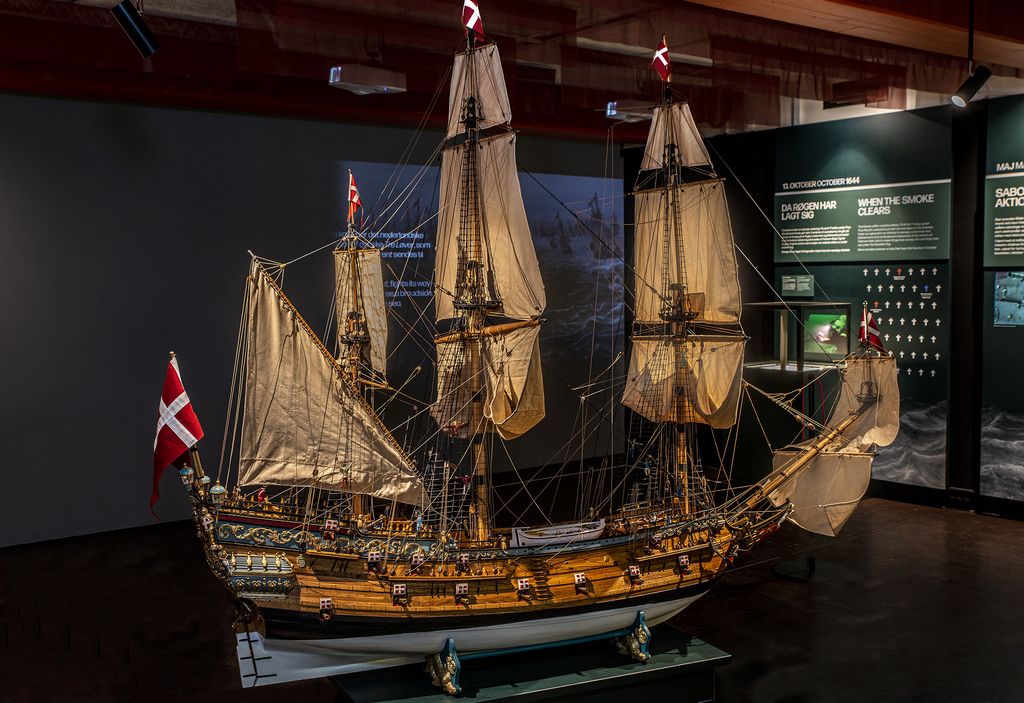
Few ships from Christian IV’s fleet are as well-documented as the warship, Fides. The original and highly-detailed building contract from 1613, which was worked out between the King and the Dutch master shipwright, Peter Michelsen, still exists and the vessel is depicted several times within the document.
The King’s ideas for the specialisation of the war fleet led to a new ship-type, suited for sailing on rivers, shallow coastal areas and open sea. Among these ships was Fides, which was built and launched in 1615 in Itzehoe, in Holstein. The powerfully-built vessel was ca. 35 m long, had an unusually shallow draught and handled incredibly well. It was equipped with sixteen 18-pounders on the gun deck and a number of smaller guns in the superstructure - 28 guns in all.
Two additional ships of the same type were also built during the proceeding years – Neldebladet (1618) and Svanen (1624).
Fides took part in both the Battle of Kolberger Heide and the Battle of Fehmarn Belt in 1644. During that fateful naval battle in Fehmarn Belt, the crew were forced to surrender to the Swedes. The ship sailed under the Swedish flag until 1659, when it was retired from service, scuttled and used as a part of the bridge construction at the mast crane in Stockholm.
Using the building contract as a starting point, maritime historian Niels M. Probst managed to successfully create drawings of Fides in 1993. These drawings were then used by Køge Maritime Modelbyggerlaug when building the 1:20 model.
The model of Fides is kindly on loan from Køge Maritime Modelbyggerlaug.
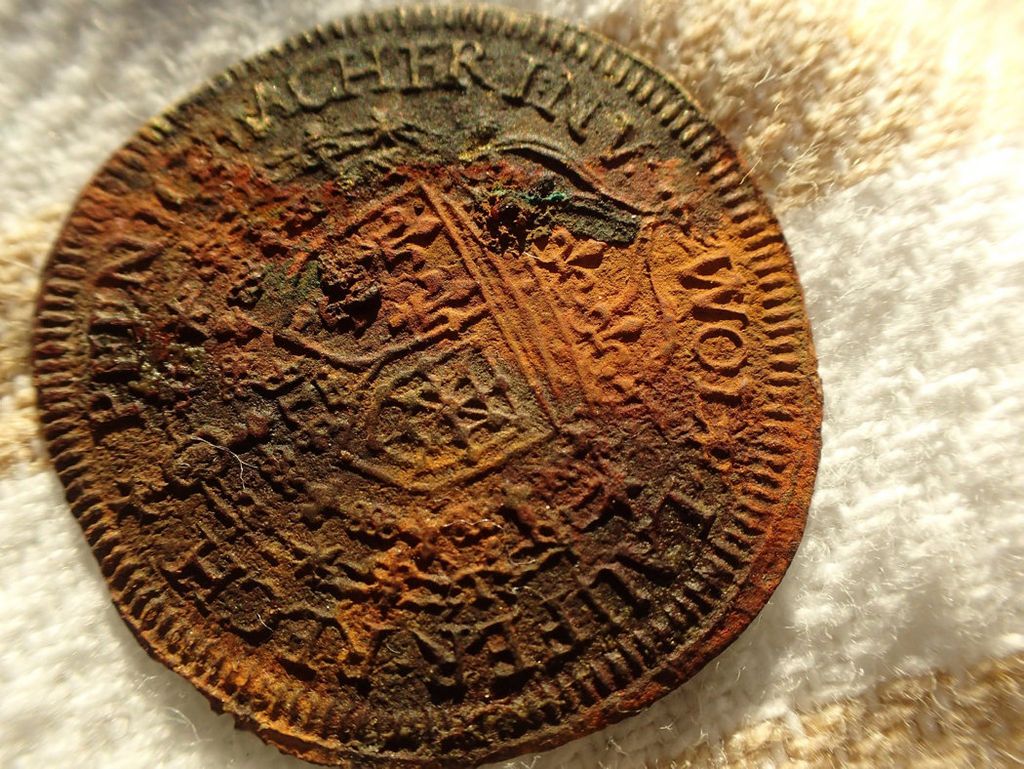
In the wreck of the Danish warship, Delmenhorst, the maritime archaeologists found several unusual artefacts. One of these was a brass disc about the size of a modern Danish five kroner coin, which at first glance, looked like an ordinary coin. This was not the case, however. It was, in fact, a jeton – a small counter used to make quick and easy calculations with roman numerals.
The jeton was used with a counting or reckoning board, marked with lines for ones, tens, hundreds and thousands and with spaces for fives, fifties etc. The jeton was one of the earliest mathematical aids and is closely related to the old-fashioned abacus. When sums were calculated, the jeton was moved along the lines. The technique for addition was quite simple but it became much more complicated when subtraction or division were required. That technique was best learned by studying the mathematical books, which were published throughout Europe.
It makes good sense to bring a jeton on a sea voyage as it was often used to calculate tolls and duties.
The majority of jetons – including the example here – were produced in the southern German town of Nürnberg, which was the centre of the European copper trade in the Middle Ages and more modern times. It is estimated that jetons were used as a method of calculation in Denmark from the middle of the 15th century until sometime in the 19th century.
In addition to their practical use – as a calculating aid – the motifs on the jetons also played a role in the transmission of ideas at the time. The most popular motifs were scenes from the Classical world as well as the French kings of the 17th and 18th centuries. This is also the case with the jeton from Delmenhorst, which is decorated with a motif of Louis XIII of France. This specific type of jeton was produced in the period from 1610 – 1643.
Jeton with motif of Louis XIII of France and crest. Manufactured in Nürnberg, Germany. Found in Delmenhorst in Fehmarn belt. Brass. 1610 – 1643.
Viking Ship Museum in Roskilde.
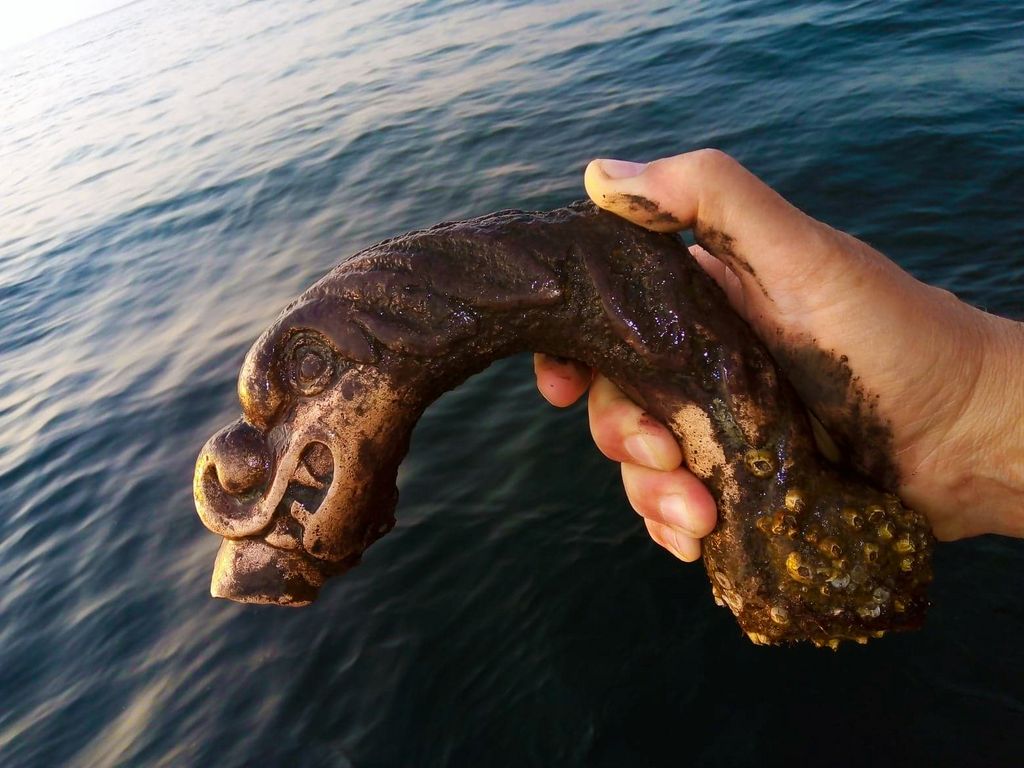
In 2020, maritime archaeologists exploring the sea floor of Fehmarn Belt, close to the coast of Lolland, were met by a beautiful sight: a seabed dotted with bronze gun fragments, which gleamed like gold between the blackened timbers of the warship, Delmenhorst. Each fragment tells a story about the violent events that led to the loss of the ship during the Battle of Fehmarn Belt in 1644.
Among the finds recovered by the archaeologists was a ’dolphin’: one of the two handles, which originally sat atop the gun. It is beautifully formed as a dolphin or some other kind of ‘sea monster’. In addition, a touch-pan cover - a bronze lid, which protects the hole from which the gun is ignited – was also found. A piece of the gun’s muzzle and a cascable, from the rear of the gun, were also found amongst the ballast stones and ship’s timbers.
Evidence of the extreme temperatures that the fragments were exposed to can be clearly seen in their deformation and in damage to their surfaces. They paint an ominous picture of Delmenhorst’s fate. During the final hours of the battle, Delmenhorst’s crew ran the ship aground and sought cover under a coastal battery – a series of defended embankments established along the coast of Lolland. The Swedish ships couldn’t come within firing range without risking taking fire from the battery. Therefore, in order to do as much damage as they could, they sent the fire-ship, Lille Delfin – a ship, which had been intentionally set on fire – towards the coast in order to ignite Delmenhorst. The Danish ship broke out into a violent and destructive fire.
The find position of the melted bronze fragments also illustrate where the guns had originally been positioned in the ship. These positions, and the number of bronze guns, were important clues when trying to identify the ship, as detailed records of the how many guns each ship in the Danish fleet carried, as well as their position on board, still exist.
The gun fragments belong to the Viking Ship Museum in Roskilde.
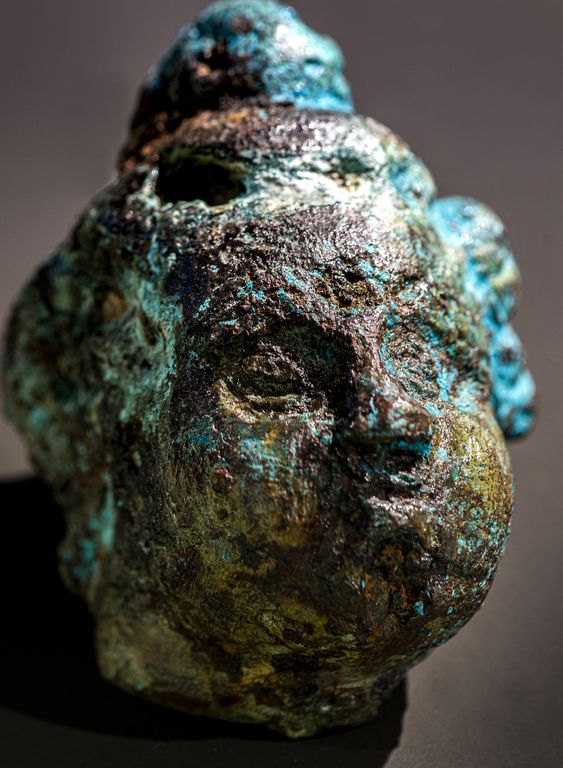
The Danish man-of-war 'Lindormen' became a victim of fire in the battle in Fehmarn Belt – ignited by both enemy gunfire and the Swedish fire-ship, 'Meerman'. The flames reached the powder magazine, the ship exploded and sunk with 50 men on board.
The wreck of 'Lindormen' lies in German waters, and when maritime archaeologists from Landesmuseum Schleswig-Holstein in 2012 investigates the ship, in advance of the establishment of a Fehmarn connection, they find clear traces of the ship's fate.
Eight larger and smaller gun fragments of bronze are scattered over around the wreck area, all damaged by fire and with visible heat damage. In the stern of the wreck was a large and almost intact gun with Christian IV's monogram, several decorative details and the gun barrel shot off. At the back of this gun sat a cascable shaped like a woman - without a head - squatting and with a grip on the tail of a sea- or fabulous animal. The woman's head was found lying elsewhere in the shipwreck, and despite heat damage, it could be interpreted as an oriental woman with full cheeks and intricate hair.
The female gun head is kindly on loan from 'Museum für Archäologie Schloss Gottorf, Landesmuseen Schleswig-Holstein'.
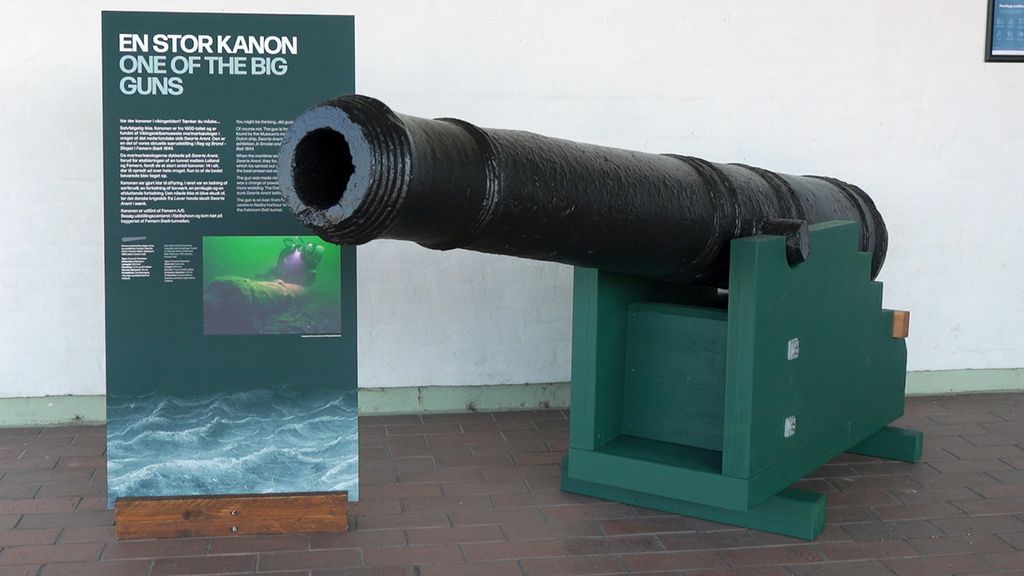
The Dutch armed vessel SWARTE ARENT were sunk by broadside of guns from the Danish man-of-war TRE LØVER.
Today the wrecks is lying in Danish waters and when maritime archaeologists from the Viking Ship Museum in 2012 investigated the wreck, they found 14 cast iron guns of different calibres.
The guns lay spread out over the whole wreck, some damaged by the battle at sea and indicating that the ships gun deck had collapsed. Found near the guns were also gun-carriages (a wagon the guns were mounted on), wooden wedges for elevation, wipers for cleaning the barrel and shots ready for use. For that reason the find was called the ‘gun-wreck’.
Two of the best preserved guns were salvaged and taken to the National Museum for preservation.
The gun exhibited on the main stairs of the Viking Ship Hall is a well-preserved 8-pound finbanker.
The finbanker guns were industrial, mass-produced guns, as opposed to the more expensive bronze guns.
They are often without any decorative details, distinctiveness or signing to can help identify the foundry.
Nevertheless, a circular mark of a G or C within a relief can be sensed on the left trunchion. It is uncertain whether this mark refers to the Dutch merchant and later Swedish nobleman Louis de Geer who not only owned the foundry in Finspång Sweden, but also aided the Swedes in the naval battle by arming a Dutch support fleet.
The gun was found with ready for firing. In the barrel, there was a charge of powder, wadding of rope, an iron ball and more wadding. In addition, on the side of the barrel is a hole the size of a small shot, presumably from the heavy fire that Tre Løver sent towards Swarte Arent.
The gun is kindly on loan from Femern A/S.
See film from when the gun arrives at the Viking Ship Museum
![[Translate to english:] Udstillingen 'I Røg og Brand' på Vikingeskibsmuseet](/frontend/Grafik/rog-og-brand-lille-side-banner-07.jpg)
![[Translate to english:] Udstillingen 'I Røg og Brand' på Vikingeskibsmuseet](/frontend/Grafik/rog-og-brand-lille-side-banner-05.jpg)
